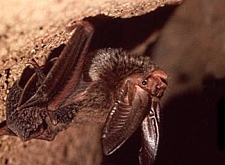Wildlife - Species

Status in SC: Imperiled
Rafinesque's Big-eared Bat
In South Carolina, Rafinesque’s big-eared bat is imperiled (S2?) and is listed as State Endangered. In North Carolina it is listed as State Threatened. Georgia and Kentucky rank these bats as Rare or Vulnerable, while Virginia and Florida rank them as Imperiled. West Virginia considers the species to be Critically Imperiled. They have a rounded global status of Rare or (G3/G4).
Rafinesque's Big-eared Bat (Plecotus rafinesquii)
Description
Bats belong to a diverse group of mammals, second to rodents in numbers of species. Rafinesque's big-eared bat, however, is among the least known of all bats in the eastern United States. As its name implies, Rafinesque's big-eared bat is distinguishable from other bats in South Carolina by its large (3 cm or 1.25 inches) ears which, when laid back, are about half the length of the animal's body. The ears are thin, have fur only along the edges, and are joined at the base across the bat's forehead. Rafinesque's big-eared bat is gray/brown above and silvery below with thin and naked membranes on its wings and tail. This big-eared bat typically weighs 8-14 grams (less than 0.5 oz)and its wingspan ranges from 26 to 30 cm (10 to 11 in). This species can be differentiated from the federally endangered Townsend's big-eared bat primarily by its darker fur and hair that extends beyond the tips of the bat's toes.
Preferred Habitat and Biology
Rafinesque's big-eared bats inhabit the southeastern United States, west to Louisiana and north to Kentucky and North Carolina. In South Carolina they are permanent residents of the coastal plain and hibernate rather than move south during winter months. Big-eared bats characteristically roost in dilapidated buildings or tree cavities near water. In the ACE Basin, Rafinesque's big-eared bats are known to inhabit Donnelley Wildlife Management Area, where they roost in an old plantation house. One of the biggest colonies in the state resides in Hampton Plantation on the South Santee River. Although not documented in the South Carolina Department of Natural Resources Heritage Trust database, this species is suspected to be in the ACE Basin.
The breeding season in this species extends from late fall to early winter. During this time, both males and females occupy the same roost. For the remainder of the winter and on to early spring, the bats hibernate. In some portions of their range, hibernating bats are found in caves, wells, and similar habitats. Males are solitary or gather in small groups during summer months, whereas females congregate in maternity colonies of up to 100 individuals. In May-June females give birth to one hairless young, which can fly at 3 weeks of age and attains adult size by August or early September. Rafinesque's big-eared bats feed exclusively on moths but will eat other insects if moths are not available. They live at least 10 years in the wild.
Species Significance
Although this species has no direct commercial value, it is extremely beneficial, along with all other species of insectivorous bats. Bats are the most important predators of nocturnal insects, some of which are harmful to humans. Bats also provide recreational opportunities; an increasing number of bat enthusiasts watch for their emergence from colonies, and commercially available bat cry detectors are gaining popularity.
Rafinesque's big-eared bat is a rare species throughout its range and an endangered species in the state of South Carolina. Rafinesque's big-eared bat is very sensitive to human activities and will abandon a roost if disturbed. If awakened while hibernating, a bat will use up precious energy reserves meant to sustain it until insects are again available in the spring. Thus, starvation brought about by disturbance causes high mortality. Disturbance of maternity colonies is also a source of mortality since adults may abandon their young or drop them to the ground. Habitat loss and alteration have also contributed to the species' decline in the past decade. Large cavity trees used for roosting are increasingly scarce.
References
Best, T.L., J.S. Altenbach, M.J. Harvey, R.R. Currie, and K. Sutton. 1997. Bats of the eastern United States. Poster. Auburn University, Auburn, AL.
Bunch, M. 1998. Personal communication. South Carolina Department of Natural Resources, Clemson, SC.
Golley, F.B. 1966. South Carolina mammals. Charleston Museum, Charleston, SC.
Harvey, J.M. 1992. Bats of the eastern United States. Arkansas Game and Fish Commission, Little Rock, Arkansas.
Webster, W.D., J.F. Parnell, and W.C. Biggs. 1985. Mammals of the Carolinas, Virginia, and Maryland. University of North Carolina Press, Chapel Hill, NC.
Whitaker, J.O. 1980. The Audubon Society field guide to North American mammals. Alfred A. Knopf, New York, NY.
